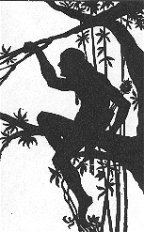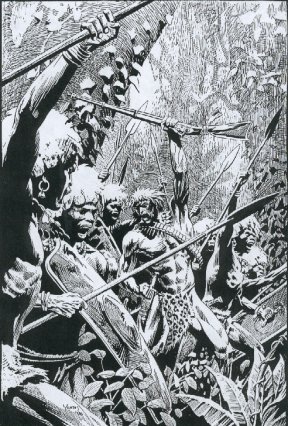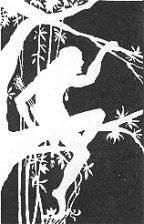
The First and Only Online Fanzine Devoted to the Life and Works of Edgar Rice Burroughs Official Edgar Rice Burroughs Tribute Site Since 1996 ~ Over 10,000 Webpages in Archive |

Tarzan versus Tarzan
Part 2 of 4Tarzan Friend...Not Kill All Black People:
An Inquiry into the Politics of the Bogeyman Business
by F. X. Blisard
Parts 1-3 of this series appeared in 1998 in The Nubian News, a weekly African-American newspaper published in Trenton, N.J. For more information, visit their Web site at:
http://www.nubiannews.com/Copyright ©2000 F. X. Blisard.
All rights reserved.
The author's thematic rendering of the famous
Fred Arting dust-jacket illustration for the first edition of
Tarzan of the Apes (McClurg 1914).
© 2000 by F.X. Blisard.
Part 1 of this series presented evidence of the hitherto unsuspected involvement in an international, turn-of-the-century "racial dialogue" on the part of Edgar Rice Burroughs (1875-1950), creator of the (in)famous modern folk-hero "Tarzan of the Apes."Tarzan of the Apes was ashamed. Hereafter he would at least wait until he knew men deserved it before he thought of killing them.--The Return of Tarzan,
Chapter 15I also contend that Edgar Rice Burroughs was, first and foremost, a satirist, in the tradition of Mark Twain, Lewis Carroll, and Jonathan Swift (writers whom he greatly admired) and that among the multiple satiric targets of his first two novels, A Princess of Mars and Tarzan of the Apes, is the peculiarly Anglo-American problem of race relations (white/red in the former, white/black in the latter).
Princess, for instance, opens with a running battle between "a Southern Gentleman of the highest type" and a band of "bloodthirsty savage redskin Apaches" and closes with that same Virginia gentleman blissfully wed to (and then forcefully separated from) a princess of the red-skinned Martians, the race that just happens to be custodian of the most advanced civilization on that red planet. Apes, on the other hand, opens with the departure from London of an English gentleman of the "noblest type" on a diplomatic mission to colonial West Africa to investigate mistreatment of "black British subjects" and closes with his son having constantly terrorized (and inadvertently caused the massacre of) the very people his father had come to "save"--shades of Joseph Conrad! (Incidentally, unlike Hollywood's version, at the end of the original novel Tarzan does not "get the girl"--fit punishment for the "sins of his youth"?) And lest the irony of all this be lost on Burroughs' original audience (as I suspect it was), the sequels to both novels are more explicit on the subject of race relations. In The Gods of Mars, for instance, the hero--formerly an officer in the Army of the Confederate States of America--"discovers" two "new" races in addition to the red and green Martians introduced in Princess:
The black pirates interested me immensely. I had heard vague rumors, little more than legends they were, during my former life on Mars; but never had I seen them.... The physical structure of their bodies seemed identical with those of the [white] therns, the red men, and my own. Only in the colour of their skin did they differ materially from us; that is of the appearance of polished ebony, and odd as it may seem for a Southerner to say it, adds to rather than detracts from their marvellous beauty.... "The First Born of Barsoom," he explained, "are the race of black men of which I am a Dator, or, as the lesser Barsoomians would say, Prince. My race is the oldest on the planet. We trace our lineage, unbroken, direct to the Tree of Life, which flourished in the centre of the Valley Dor twenty-three million years ago." ... "The therns," and he smiled maliciously as he spoke, "are but the result of ages of evolution from the pure white ape of antiquity. They are a lower order still. There is but one race of true and immortal humans on Barsoom. It is the race of black men." (Gods of Mars, Chapters 6-7)
(In this connection, please note the complete absence of black people on the planet Mongo. I just can't imagine all-American polo-champ Flash Gordon tolerating such a boast from the lips of "colored folk.") Similarly, in The Return of Tarzan, Burroughs seems to deliberately reverse the racial situation that had prevailed in Apes (apparently, in response to at least one reader's "misreading" of that complex first novel):
Like lightning Numa turned upon this new enemy, and, defenseless as he was, Tarzan of the Apes was nearer to death that instant than he ever before had been. It was the black who saved him. The warrior realized in an instant that he owed his life to this strange white man, and he also saw that only a miracle could save his preserver from those fierce yellow fangs that had been so near to his own flesh.... With the quickness of thought his spear arm flew back, and then shot forward with all the force of the sinewy muscles that rolled beneath the shimmering ebon hide. True to its mark the iron-shod weapon flew, transfixing Numa's sleek carcass from the right groin to beneath the left shoulder.... Then Tarzan arose, and the black man and the white looked into each other's eyes across the body of their kill--and the black made the sign of peace and friendship, and Tarzan of the Apes answered it in kind.... [Afterward,] there was nothing in all the village he could not have had for the asking.... How much easier this was, thought Tarzan, than murder and robbery to supply his wants. How close he had been to killing this man whom he had never seen before, and who now was manifesting by every primitive means at his command friendship and affection for his would-be slayer. Tarzan of the Apes was ashamed. Hereafter he would at least wait until he knew men deserved it before he thought of killing them. (The Return of Tarzan, Chapters 14-15)
Nor did Burroughs stop there. In virtually every Tarzan novel he wrote, as well as many of his other novels, and in numerous incidents from his own daily life, the same theme (race relations) keeps cropping up. The following examples are documented in Irwin Porges' 1975 Burroughs biography cited above (in Part 1 of this series):
A. Ed's (pre-rastafarian!) vision of a 22nd-century Neo-Ethiopian Empire extending into Europe and Asia (in his 1915 short story, "Beyond Thirty");How did it come about that so conscientious an author--and his works--became so villified? Why... through the magic of Hollywood, of course! With the very first Tarzan movie (a 1918 black-and-white, silent version of the1912 novel Tarzan of the Apes), Hollywood's vision of the already famous jungle hero diverged sharply from his original characterization. Burroughs had created a fairly complex literary figure, a kind of multi-cultural iconoclast who could effectively deliver the author's unique brand of anti-modern satiric commentary; Hollywood promptly turned him into an uncultured cultural icon that could be manipulated to shore up Anglo-American cultural imperialism in "faraway places with strange-sounding names" (and in places much closer to home, such as, New York, Detroit, Los Angeles, etc.). Thus did "Tarzan of the Movies" become established as the implacable foe of all indigenous Africans (and, in effect, of successive generations of African-Americans), a role which Burroughs had studiously avoided in the first half-dozen Tarzan novels he wrote between 1911 and 1918--and which he deliberately combatted in various ways thereafter, as Hollywood's hold on the public perception of the ape-man steadily increased.B. His struggle to publish a series of historical fiction vindicating the Apaches as victims of white oppression (1926-1933; realized in his novels Apache Devil and The War Chief);
C. His repeated attempts to gain national support for a grassroots, interracial youth movement (the "Tarzan Tribes/Clans") that grew to rival the Boy Scouts of [Anglo-]America (1916-1939);
D. His wartime hobnobbing with the highly decorated (yet still segregated) negro brigade known as the "Harlem Hellfighters" (1942);
E. His creation of yet another "black civilization" on a par with other "advanced races" at the earth's core (in his 1944 novel, Land of Terror); and
F. His frank but politically astute editorializing about post-World War II geopolitical decisions (e.g., in the 4/15/45 installment of his syndicated wartime column, "Laugh It Off," in which he demonstrated a prescient understanding of the psychological complexities of racial discrimmination in post-colonial Africa).
Once burned, for instance, the author insisted on--and got--a standard disclaimer ("Based on characters created by Edgar Rice Burroughs") prominently displayed in the opening credits of future Tarzan films that deviated from his original story lines. The few Tarzan films with which Burroughs (at his own expense) was personally involved as scriptwriter or producer (e.g., Tarzan the Fearless; Tarzan and the Green Goddess; The Son of Tarzan; Tarzan and the Golden Lion) portray not only intelligent and fully-functioning Tarzans, but also intelligent and fully-functioning blacks, unlike the "mainstream" Hollywood Tarzan movies. Hollywood's Tarzan remained a barely articulate muscleman, and the films just became more and more absurd. That is why the 1985 film Greystoke was such a breakthrough--here at last was some glimmer of intelligence in the ol' ape-man, even if overshadowed by all that existential angst. By this time, however, Hollywood was so intimidated by the Civil Rights and Black Power movements that the role of indigenous Africans in the script of Greystoke was kept to an absolute minimum--a trend which may well continue unless certain "works in progress" can be "headed off at the pass."
[Next issue--Part 3: Tarzan a' la Disney:
Animated Ape-Man to Reveal Corporation's True Colors]

Copyright © 1997 by Thomas Yeates. All rights reserved.
Tarzan the Mau Mau Man?Classic Tom Yeates rendering of a pivotal--but poorly publicized--episode from Burroughs' 1912 novel, The Return of Tarzan , in which the ape-man becomes an honorary member (and permanent war-chief) of an indigenous black African warrior clan resisting the depredations of would-be 20th-century slavers.Reprinted with the artist's permission.
(This illustration also served as the frontispiece for The Return of Tarzan, adapted and illustrated by Tom Yeates, published in 1997 by Dark Horse Comics, Inc., 10956 SE Main Street, Milwaukie, OR 97222.)
